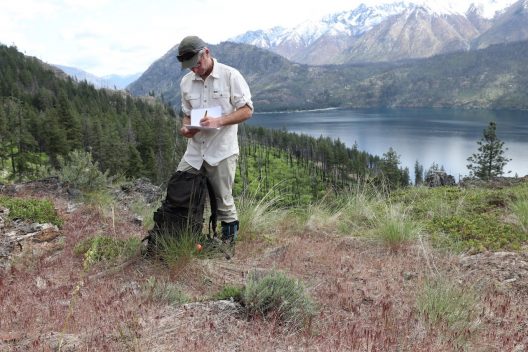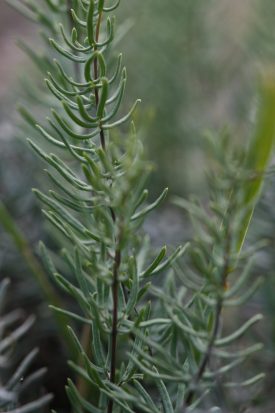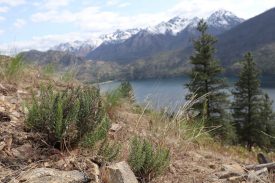Sierra Cliffbrake

by Josh Wozniak

Lake Chelan is a narrow, glacially-carved trench: 50 miles long from North Cascades National Park to the town of Chelan. Along its shores, species typical of both the east and west flanks of the Cascades Range are well-represented. The areas surrounding the lake also contain a number of rare plant species, including some that occur nowhere else in Washington. One of these species is Sierra cliffbrake (Pellaea brachtyptera), identified as a priority for study by land managers in North Cascades National Park and Okanogan-Wenatchee National Forest. Its only known occurrence in Washington is along the north side of the lake, in a handful of populations identified during plant surveys in 1986 (Alverson and Arnett 1986). Otherwise, it occurs primarily in the Sierra Mountains of California, extending north along the Cascades Range to central Oregon (Camp and Gamon 2011, Hitchcock and Cronquist 2018, Hickman 1993).

Rare Care volunteers Katie and Steve Messick were given the assignment in 2017. Their survey confirmed early summer would be optimal for surveys, the sites were steep, and the presence of a systematic error in the spatial data associated with the historical archives (datum shift, or other offset). Katie and Steve returned in May 2018, joined by Julia Munger, Shelby Petro, George Ritchotte, and myself. Katie and I are trained Rare Care survey leads, and all of us have conducted many plant surveys previously. Initial survey work did indeed support the hypothesis that the archived mapping was consistently about 1,500 feet horizontally and 200-300 feet vertically offset from the actual population locations. This certainly contributed to the difficulty previous surveyors experienced in attempting to re-locate these populations. Our survey crew in 2018 re-located all the populations in the vicinity of Rainbow Falls and identified a number of new populations in similar adjacent habitats.
The crew returned in 2019 and completed surveys of all the previously identified populations within the valley. They confirmed the persistence of all but one population, located in an area that experienced a large fire in 2010 and was now dominated by a robust, neck-deep stand of snowbrush (Ceanothus velutinus). It is unknown whether the Pellaea is persisting in the understory of the Ceanothus and downed logs, but they escaped our detection. The remainder of the survey sites were completed in 2019, 2020 and 2021.
In 2021, a new population was found south of the known population. Moving south, the populations began to increase, culminating at the south end of the trail where hundreds of populations occur in a fascinating and unique landscape co-dominated by another locally rare plant with a primary range in the California Sierra, green leaf manzanita (Arctostaphalos patula).
Throughout its distribution at Lake Chelan, P. brachyptera grew in loose rocky soil, often near rock outcroppings and warm exposures, with a preference for sites with fine views of the lake. These habitats are very prone to impacts from fire, forest encroachment from fire suppression and invasive species. Except at its southernmost extent, the species occurred in a narrow elevation band, and in areas with sparse vegetation adapted for harsh, dry conditions. Pinemat manzanita (Arctostaphalos nevadensis), Oregon cliff-fern (Woodsia oregana) and cliff-fern (W. scopulina), Oregon cliff-brake (Aspidotis densa) and death camas (Toxicoscordion venuosum) were common associates.
To read more about this monitoring effort, check out Josh’s article in the most recent edition of Douglasia: “Unique Habitats of Lake Chelan: Rare Plants Occupying an Equally Rare Geologic Niche”.
Literature cited:
Alverson, E. and J. Arnett. 1986. Plant Life of the North Cascades: Lake Chelan-Sawtooth Ridge, Stehekin Valley, and Glacier Peak. Douglasia Occasional Papers. Washington Native Plant Society, Vol 2.
Hickman, James C., ed. 1993. The Jepson Manual: Higher Plants of California. University of California Press. Berkeley and Los Angeles California.
Hitchcock, C.L. and A. Cronquist. 2018. Flora of the Pacific Northwest: An Illustrated Manual, 2nd Edition. Edited by D.E. Giblin, B.S. Legler, P.F. Zika, and R.G. Olmstead. University of Washington Press, Seattle, WA. 882 pp.
Oregon Flora. 2021. Spatial Data on Pellaea brachyptera distribution. Accessed via website: https://oregonflora.org/taxa/index.php?taxon=7042